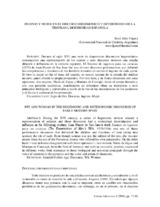Mostrar el registro sencillo del ítem
Ingenio y mujer en el discurso hegemónico y heterónomo de la temprana modernidad española
| dc.contributor.author | Aldo Vijarra, René | |
| dc.date.accessioned | 2019-04-05T08:53:53Z | |
| dc.date.available | 2019-04-05T08:53:53Z | |
| dc.date.issued | 2018 | |
| dc.identifier.issn | 2659-4281 | es_ES |
| dc.identifier.uri | http://hdl.handle.net/10396/18364 | |
| dc.description.abstract | Durante el siglo XVI, una serie de dispositivos discursivos hegemónicos construyeron una representación de los sujetos y esos discursos tuvieron una amplia difusión e influencia en la centuria siguiente. El Examen de ingenios para las ciencias (1575) de Juan Huarte de San Juan fue uno de esos discursos performativos que delimitó las competencias y funciones de los hombres teniendo en cuenta el ingenio de cada quien. Si bien la mujer no fue el tema del tratado, no estuvo ausente de la mirada del médico navarro, quien ofreció su propia perspectiva. Por otro lado, y en franca disidencia con estas opiniones, dos mujeres, María de Zayas y Mariana de Carvajal, desde el campo literario y con una posición excéntrica, manifestaron en diferentes obras su resistencia a esos principios biológicos y universales a través de la voz de las enunciadoras de los paratextos y de la voz y accionar de los personajes. | es_ES |
| dc.description.abstract | During the XVI century, a series of hegemonic devices created a representation of subjects and those discourses had a widespread dissemination and influence in the following century. Juan Huarte de San Juan’s work Examen de ingenios para las ciencias (The Examination of Men’s Wits, 1575/1594) was one of those performative discourses that delimited the abilities and functions of men taking into account the wit of each. Even though woman was not the subject of the text, she was not absent from the eye of the Navarrese doctor, who offered his own perspective. On the other hand ––and in honest disagreement with those opinions—, two women, María de Zayas and Mariana de Caravajal, from the field of literature and with an ex-centric position, expressed in different works their resistance to those biological and universal principals through the voice of speakers in the paratexts and the voice and action of characters. | es_ES |
| dc.format.mimetype | application/pdf | es_ES |
| dc.language.iso | spa | es_ES |
| dc.publisher | UCOPress | es_ES |
| dc.rights | https://creativecommons.org/licenses/by-nc-nd/4.0/ | es_ES |
| dc.source | Esferas literarias 1, 75-86 (2018) | es_ES |
| dc.subject | Siglo de Oro | es_ES |
| dc.subject | Discursos | es_ES |
| dc.subject | Ingenio | es_ES |
| dc.subject | Mujeres | es_ES |
| dc.subject | Spanish Golden Age | es_ES |
| dc.subject | Discourses | es_ES |
| dc.subject | Wit | es_ES |
| dc.subject | Women | es_ES |
| dc.title | Ingenio y mujer en el discurso hegemónico y heterónomo de la temprana modernidad española | es_ES |
| dc.title.alternative | Wit and woman in the hegemonic and heteronomic discourse of Early Modern Spain | es_ES |
| dc.type | info:eu-repo/semantics/article | es_ES |
| dc.relation.publisherversion | http://www.uco.es/ucopress/ojs/index.php/Esferas/index | es_ES |
| dc.rights.accessRights | info:eu-repo/semantics/openAccess | es_ES |

